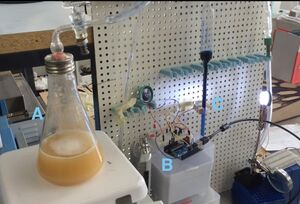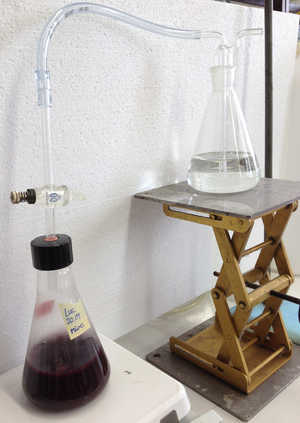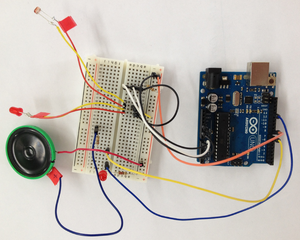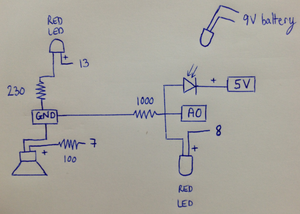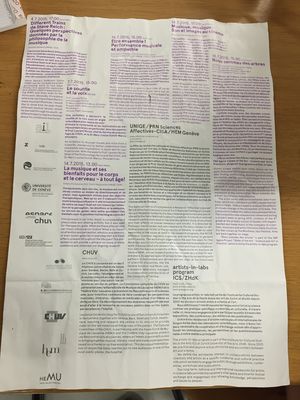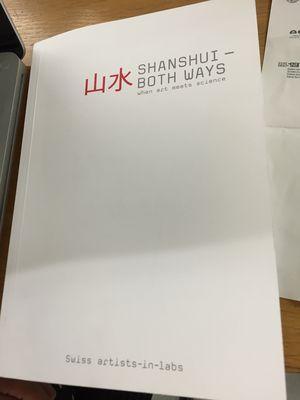Living Instruments
Living Instruments is the tentative title for a collaborative project between London-based musician Serge Vuille (under the umbrella of his project WeSpoke), Hackuarium and the DIYbio community at large. The final deliverable is a concert that will take place on February 10th 2016, at the music and performance art venue Le Bourg, in Lausanne, Switzerland.
What
EN - This collaboration aims at three goals:
- To built a set of living instruments that use biological information or organisms as sources of signal.
- To compose a musical piece (creation) using these instrument and turning their output signal into sound
- Place this project in the context of the current state of DIY, science and music
FR - Cette collaboration a trois buts:
- Construire des instruments vivants (intégrant le vivant comme source de signal)
- Création d'une œuvre musicale (composition) en utilisant ces instruments
- Placer la démarche collaborative dans le contexte DIY, scientifique, et musical
Who is involved?
- Serge Vuille
- Vanesa Lorenzo
- Luc Henry
- Yann Heurtaux
- Etienne Ndiaye
- You?
When
EN - The concert is planned on February 10th 2016, at Le Bourg, Lausanne.
FR - Le concert est prévu le 10 février 2016, au Bourg, Lausanne.
What's Next
We are a small team working on the prototype we built during 'A long week-end dedicated to biomusical innovation' on 2015.09.19-21.
The project will be running until early February 2016 so there will be plenty of time to help.
More to come! We will update you on the next residence and events dedicated to bringing living instruments to life!
Log
Prototyping Week-end 19-21.09.2015
Saturday 19th September 11am - 7pm
Sunday 20th September 10am - 8pm
Monday 21st September 10am - 6pm
Who was there?
We spent those three days brainstorming at UniverCité, trying to design 'instruments' that we could play, based on fermenting yeast cultures.
(Thanks biodesign.cc for the soldering iron!)
Together with Serge Vuille, our musician in residence, we designed and built a series of living instrument prototypes.
Overview of the prototype:
Before we go into too much details, you can check the video!
Now a bit more details:
A. is the 250mL yeast culture producing the CO2.
B is the electronic circuit that allows our Arduino UNO board to make a variable sound when gas bubbles are going through the glass tube filled with ink-coloured water.
C is simply a photodiode that will sense white light (from white LEDs) when the bubbles pass by.
Below you find a picture of the setting, the recipe to produce CO2 from yeast fermentation and a scheme of the bubble detector device.
Tubing set-up:
Fermentation cultures:
We used two different types of cultures to produce CO2 gas:
- As a test, we used random culture from rotting fruits juice.
- Blackberries were squashed into a juice and diluted with 1/5 water (40 mL into 160 mL) and the mixture stirred at room temperature. There was an immediate production of CO2 gas.
- To get something more reproducible, we used pure brewing yeast cultures feeding on glucose.
- The composition of the overnight medium was as follow: 2.5g YE, 5g Peptone, 5g glucose in 250mL dd water ->sterilised in autoclave
- Starting from 2mL dense culture (from overnight growth) in 200 mL fresh medium, the optical density after 5 hours was 0.81 (closed vial) and 0.74 (open vial). The next morning it was 2.75 in open vial at 31°C and 2.89 in closed vial at 25°C.
- We added 50 mL of 40% glucose solution (not sterile) -> 8% final glucose concentration.
- The cultures started producing CO2 after 10 minutes.
Arduino bubble detector:
Kick off Fri 24.07.2015
- Constat de Serge : Musique classique et contemporaine : déconnectée d'une réalité et d'un public de plus en plus large.
- Collaboration proposée : résidence au Bourg, 2e mercredi du mois, de janvier à mai 2016. Concert prévu le 10 février 2016. Création d'une nouvelle œuvre.
- Reprendre le format d'un concept que Serge programme déjà au Café OTO à Londres : https://www.cafeoto.co.uk/ https://www.facebook.com/pages/Kammer-Klang/702751833151411
- Projet pilote pour attirer nouveau public, établir ça sur 4 concerts par année au Bourg http://www.le-bourg.ch/
- We Spoke jouerait des pièces de répertoire ou donnerait la scène à d'autres ; travail avec d'autres institutions pour de la nouveauté
- Modèle de concert qui soit un labo, beaucoup d'interactions
- Pièces écrites aujourd'hui avec des sensors cf. Alexander Schubert
- Besoin : passer en vue la question de l'interface. La science peut-elle générer du signal qui peut produire/être transformée en son.
- Comment insérer bio/électronique en tant qu'output de qualité utilisable
- Data ? Vivant ?
- Peut être une présentation de l'ordre de 10 à 45 minutes pour la pièce finale
- Next steps : petite recherche de projets similaires. cf. Vanesa, affiche CHUV
- Inspiration? : http://liagiraud.com/experiences/immersion/
- Résidence Serge : 19-20/9, étendre au 23 pour présenter lors d'un Open Hackuarium?
